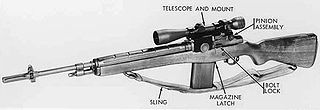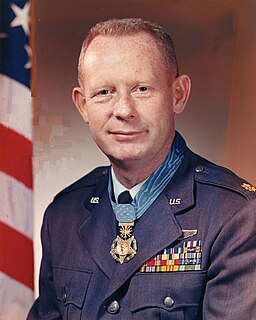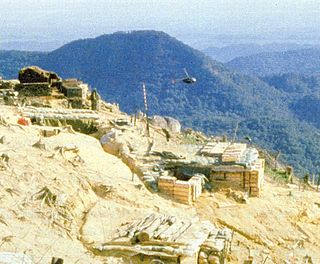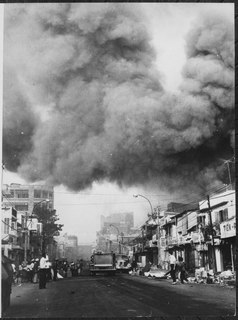
Okinawa Prefecture is a prefecture of Japan located on the Ryukyu Islands. Okinawa Prefecture has a population of 1,457,162 and has a geographic area of 2,280 km².

The Vietnam War, also known as the Second Indochina War, and in Vietnam as the Resistance War Against America or simply the American War, was a conflict in Vietnam, Laos, and Cambodia from 1 November 1955 to the fall of Saigon on 30 April 1975. It was the second of the Indochina Wars and was officially fought between North Vietnam and South Vietnam. North Vietnam was supported by the Soviet Union, China, and other communist allies; South Vietnam was supported by the United States, South Korea, the Philippines, Australia, Thailand, and other anti-communist allies. The war, considered a Cold War-era proxy war by some, lasted 19 years, with direct U.S. involvement ending in 1973, and included the Laotian Civil War and the Cambodian Civil War, which ended with all three countries becoming communist in 1975.

The 101st Airborne Division is a light infantry division of the United States Army specializing in air assault operations. The Screaming Eagles were referred to as "the tip of the spear" by former U.S. Secretary of Defense Robert Gates and the most potent and tactically mobile of the U.S. Army's divisions by former Chief of Staff of the Army GEN Edward C. Meyer (ret). The 101st Airborne is able to plan, coordinate, and execute brigade-size air assault operations capable of seizing key terrain in support of operational objectives and is capable of working in austere environments with limited or degraded infrastructure. These operations can be conducted by mobile teams covering large distances and engaging enemy forces behind enemy lines. According to the author of Screaming Eagles: 101st Airborne Division, its unique battlefield mobility and high level of training have kept it in the vanguard of US land combat forces in recent conflicts. More recently, the 101st Airborne has been performing foreign internal defense and counterterrorism operations within Iraq and Afghanistan.

Harold Gregory Moore Jr. was a United States Army lieutenant general and author. He was awarded the Distinguished Service Cross, the U.S. military's second-highest decoration for valor, and was the first of his West Point class (1945) to be promoted to brigadier general, major general, and lieutenant general.
The SS Columbia Eagle incident refers to a mutiny that occurred aboard the U.S. flagged merchant vessel Columbia Eagle in March 1970 when two crewmembers seized the vessel with the threat of a bomb and handgun, and forced the master to sail to Cambodia. The ship was under contract with the Military Sea Transportation Service to carry napalm bombs to be used by the U.S. Air Force during the Vietnam War and was originally bound for Sattahip, Thailand. During the mutiny, 24 of the crew were forced into two lifeboats and set adrift in the Gulf of Thailand while the remainder of the crew were forced to take the ship to a bay near Sihanoukville, Cambodia. The two mutineers requested political asylum from the Cambodian government which was initially granted but they were later arrested and jailed. Columbia Eagle was returned to U.S. control in April 1970. This is the only mutiny of a United States Ship in recent history.

The American Forces Network (AFN) is a government television and radio broadcast service the U.S. military provides to those stationed or assigned overseas. Headquartered at Fort George G. Meade, Maryland, AFN's broadcast operations, which include global radio and television satellite feeds, emanate from the AFN Broadcast Center/Defense Media Center in Riverside, California. AFN was founded on 26 May 1942, in London as the Armed Forces Radio Service (AFRS).

The M21 Sniper Weapon System (SWS) "in the US Army is a national match grade M14 rifle, selected for accuracy, and renamed the M21 rifle." The M21 uses a "commercially procured" 3–9× variable power telescopic sight, modified for use with the sniper rifle. It is chambered for the 7.62×51mm NATO cartridge.

Civilian Irregular Defense Group program was a program developed by the U.S. government in the Vietnam War to develop South Vietnamese irregular military units from minority populations.

Bernard Francis "Bernie" Fisher was a United States Air Force officer and a recipient of the U.S. military's highest decoration, the Medal of Honor. He was the first Air Force member to receive the medal in the Vietnam War.

The Battle of Fire Support Base Ripcord was a 23-day battle between elements of the U.S. Army 101st Airborne Division and two reinforced divisions of the People's Army of Vietnam (PAVN) that took place from 1 to 23 July 1970. It was the last major confrontation between United States ground forces and the PAVN during the Vietnam War. Three Medals of Honor and six Distinguished Service Crosses were awarded to participants for actions during the operations.

The First Battle of Saigon, fought during the Tet Offensive of the Vietnam War, was the coordinated attack by communist forces, including both the North Vietnamese Army and the Viet Cong (VC), against Saigon, the capital of South Vietnam.
The Battle of Nam Đông took place from July 5–6 1964 during the Vietnam War, when the Viet Cong (VC) and People's Army of Vietnam (PAVN) attacked the Nam Đông CIDG camp in an attempt to overrun it. During the battle, 57 South Vietnamese defenders, two Americans, an Australian Military advisor, and at least 62 attackers were killed.

The attack on Camp Holloway occurred during the early hours of February 7, 1965, in the early stages of the Vietnam War. Camp Holloway was a helicopter facility constructed by the United States Army near Pleiku in 1962. It was built to support the operations of Free World Military Forces in the Central Highlands of South Vietnam.
Operation New Life was the care and processing on Guam of Vietnamese refugees evacuated from Saigon in the closing days of the Vietnam War. More than 111,000 of the evacuated 130,000 Vietnamese refugees were transported to Guam where they were housed in tent cities for a few weeks while being processed for resettlement. The great majority of the refugees were resettled in the United States. A few thousand were resettled in other countries or chose to return to Vietnam on the vessel Thuong Tin.

The Army of the Republic of Vietnam Special Forces were the elite military units of the Army of the Republic of Vietnam (ARVN). Following the establishment of the Republic of Vietnam in October 1955, the Special Forces were formed at Nha Trang in February 1956. During the rule of Ngô Đình Diệm, the Special Forces were run by his brother, Ngô Đình Nhu, until both were assassinated in November 1963 in a coup. The Special Forces were disbanded in 1975 when South Vietnam ceased to exist after the Fall of Saigon.
The Battle of Ban Houei Sane was a battle of the Vietnam War that began on the night of 23 January 1968, when the 24th Regiment of the People's Army of Vietnam (PAVN) 304th Division overran the small Royal Lao Army outpost at Ban Houei Sane. The fighting at Ban Houei Sane was one in a series of battles fought between North Vietnamese and Allied forces during the Tet Offensive. The small outpost, defended by the 700 man Bataillon Volontaire (BV-33), was attacked and overwhelmed by the vastly superior PAVN and their PT-76 light tanks. The failure of BV-33 to defend their outpost at Ban Houei Sane would have negative consequences only a few weeks later, when the PAVN would strike again at Lang Vei.

Operation Birmingham was a military operation of the Vietnam War in War Zone C, north of Saigon conducted by the U.S. 1st Infantry Division and the Army of the Republic of Vietnam (ARVN) 5th Division from 24 April to 17 May 1966.
Operation Nevada Eagle was a security operation during the Vietnam War in Thừa Thiên Province, that took place from 17 May 1968 to 28 February 1969.
Operation Walker was a security operation conducted during the Vietnam War by the U.S. Army’s 1st Battalion, 503rd Infantry Regiment, 173rd Airborne Brigade in Bình Định Province, South Vietnam from 17 March 1968 to 31 January 1969.












